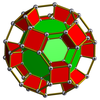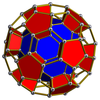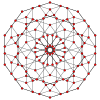This is the current revision of this page, as edited by David Eppstein (talk | contribs) at 05:20, 14 August 2024 (rm dead courtesy link for book). The present address (URL) is a permanent link to this version.
Revision as of 05:20, 14 August 2024 by David Eppstein (talk | contribs) (rm dead courtesy link for book)(diff) ← Previous revision | Latest revision (diff) | Newer revision → (diff) Prism with a 6-sided base| Uniform hexagonal prism | |
|---|---|

| |
| Type | Prismatic uniform polyhedron |
| Elements | F = 8, E = 18, V = 12 (χ = 2) |
| Faces by sides | 6{4}+2{6} |
| Schläfli symbol | t{2,6} or {6}×{} |
| Wythoff symbol | 2 6 | 2 2 2 3 | |
| Coxeter diagrams | |
| Symmetry | D6h, , (*622), order 24 |
| Rotation group | D6, , (622), order 12 |
| References | U76(d) |
| Dual | Hexagonal dipyramid |
| Properties | convex, zonohedron |
 Vertex figure 4.4.6 | |

In geometry, the hexagonal prism is a prism with hexagonal base. Prisms are polyhedrons; this polyhedron has 8 faces, 18 edges, and 12 vertices.
Since it has 8 faces, it is an octahedron. However, the term octahedron is primarily used to refer to the regular octahedron, which has eight triangular faces. Because of the ambiguity of the term octahedron and tilarity of the various eight-sided figures, the term is rarely used without clarification.
Before sharpening, many pencils take the shape of a long hexagonal prism.
As a semiregular (or uniform) polyhedron
If faces are all regular, the hexagonal prism is a semiregular polyhedron, more generally, a uniform polyhedron, and the fourth in an infinite set of prisms formed by square sides and two regular polygon caps. It can be seen as a truncated hexagonal hosohedron, represented by Schläfli symbol t{2,6}. Alternately it can be seen as the Cartesian product of a regular hexagon and a line segment, and represented by the product {6}×{}. The dual of a hexagonal prism is a hexagonal bipyramid.
The symmetry group of a right hexagonal prism is D6h of order 24. The rotation group is D6 of order 12.
Volume
As in most prisms, the volume is found by taking the area of the base, with a side length of , and multiplying it by the height , giving the formula:
and its surface area can be .
Symmetry
The topology of a uniform hexagonal prism can have geometric variations of lower symmetry, including:
| Name | Regular-hexagonal prism | Hexagonal frustum | Ditrigonal prism | Triambic prism | Ditrigonal trapezoprism |
|---|---|---|---|---|---|
| Symmetry | D6h, , (*622) | C6v, , (*66) | D3h, , (*322) | D3d, , (2*3) | |
| Construction | {6}×{}, |
t{3}×{}, |
s2{2,6}, | ||
| Image | 
|

|

|

| |
| Distortion | 
|

|
 
|

| |
As part of spatial tesselations
It exists as cells of four prismatic uniform convex honeycombs in 3 dimensions:
| Hexagonal prismatic honeycomb |
Triangular-hexagonal prismatic honeycomb |
Snub triangular-hexagonal prismatic honeycomb |
Rhombitriangular-hexagonal prismatic honeycomb |

|

|

|

|
It also exists as cells of a number of four-dimensional uniform 4-polytopes, including:
Related polyhedra and tilings
| Uniform hexagonal dihedral spherical polyhedra | ||||||||||||||
|---|---|---|---|---|---|---|---|---|---|---|---|---|---|---|
| Symmetry: , (*622) | , (622) | , (2*3) | ||||||||||||

|

|

|

|

|

|

| ||||||||
| {6,2} | t{6,2} | r{6,2} | t{2,6} | {2,6} | rr{6,2} | tr{6,2} | sr{6,2} | s{2,6} | ||||||
| Duals to uniforms | ||||||||||||||

|

|

|

|

|

|

|

|

| ||||||
| V6 | V12 | V6 | V4.4.6 | V2 | V4.4.6 | V4.4.12 | V3.3.3.6 | V3.3.3.3 | ||||||
This polyhedron can be considered a member of a sequence of uniform patterns with vertex figure (4.6.2p) and Coxeter-Dynkin diagram ![]()
![]()
![]()
![]()
![]() . For p < 6, the members of the sequence are omnitruncated polyhedra (zonohedrons), shown below as spherical tilings. For p > 6, they are tilings of the hyperbolic plane, starting with the truncated triheptagonal tiling.
. For p < 6, the members of the sequence are omnitruncated polyhedra (zonohedrons), shown below as spherical tilings. For p > 6, they are tilings of the hyperbolic plane, starting with the truncated triheptagonal tiling.
| *n32 symmetry mutation of omnitruncated tilings: 4.6.2n | ||||||||||||
|---|---|---|---|---|---|---|---|---|---|---|---|---|
| Sym. *n32 |
Spherical | Euclid. | Compact hyperb. | Paraco. | Noncompact hyperbolic | |||||||
| *232 |
*332 |
*432 |
*532 |
*632 |
*732 |
*832 |
*∞32 |
|
|
|
| |
| Figures | 
|

|

|

|

|

|

|

|

|

|

| |
| Config. | 4.6.4 | 4.6.6 | 4.6.8 | 4.6.10 | 4.6.12 | 4.6.14 | 4.6.16 | 4.6.∞ | 4.6.24i | 4.6.18i | 4.6.12i | 4.6.6i |
| Duals | 
|

|

|

|

|

|

|

|

|

|

|

|
| Config. | V4.6.4 | V4.6.6 | V4.6.8 | V4.6.10 | V4.6.12 | V4.6.14 | V4.6.16 | V4.6.∞ | V4.6.24i | V4.6.18i | V4.6.12i | V4.6.6i |
See also
| Family of uniform n-gonal prisms | |||||||||||||
|---|---|---|---|---|---|---|---|---|---|---|---|---|---|
| Prism name | Digonal prism | (Trigonal) Triangular prism |
(Tetragonal) Square prism |
Pentagonal prism | Hexagonal prism | Heptagonal prism | Octagonal prism | Enneagonal prism | Decagonal prism | Hendecagonal prism | Dodecagonal prism | ... | Apeirogonal prism |
| Polyhedron image | ... | ||||||||||||
| Spherical tiling image | Plane tiling image | ||||||||||||
| Vertex config. | 2.4.4 | 3.4.4 | 4.4.4 | 5.4.4 | 6.4.4 | 7.4.4 | 8.4.4 | 9.4.4 | 10.4.4 | 11.4.4 | 12.4.4 | ... | ∞.4.4 |
| Coxeter diagram | ... | ||||||||||||
References
- ^ Pugh, Anthony (1976), Polyhedra: A Visual Approach, University of California Press, pp. 21, 27, 62, ISBN 9780520030565.
- Simpson, Audrey (2011), Core Mathematics for Cambridge IGCSE, Cambridge University Press, pp. 266–267, ISBN 9780521727921.
- Wheater, Carolyn C. (2007), Geometry, Career Press, pp. 236–237, ISBN 9781564149367
External links
- Uniform Honeycombs in 3-Space VRML models
- The Uniform Polyhedra
- Virtual Reality Polyhedra The Encyclopedia of Polyhedra Prisms and antiprisms
- Weisstein, Eric W. "Hexagonal prism". MathWorld.
- Hexagonal Prism Interactive Model -- works in your web browser
This polyhedron-related article is a stub. You can help Misplaced Pages by expanding it. |
 , and multiplying it by the height
, and multiplying it by the height  , giving the formula:
, giving the formula:
 and its surface area can be
and its surface area can be
 .
.












